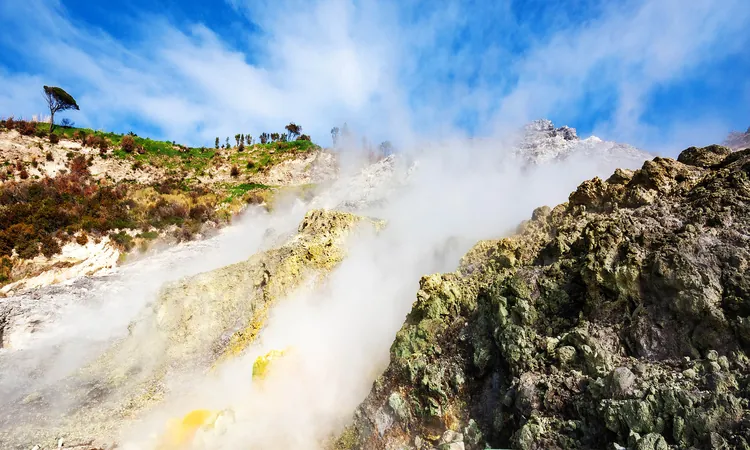
Is the Supervolcano Near Naples About to Erupt? Scientists Say a Major Investigation is Underway!
2024-11-29
Author: Jia
The Phlegraean Fields, an expansive supervolcano located just west of Naples, Italy, are showing signs of awakening, leaving scientists both intrigued and concerned.
These volcanic fields are recognized as one of the top eight sources of volcanic carbon dioxide emissions globally. Since 2005, the Solfatara crater within these fields has been notable for its increasing gas emissions, drawing attention from researchers and residents alike.
A Deeper Look into Gas Emissions
Gianmarco Buono, a volcanologist at the Italian National Institute of Geophysics and Volcanology (INGV), is spearheading a detailed analysis to determine the cause of this extraordinary rise in gas output. Buono emphasizes that "understanding the source of carbon dioxide is essential for reconstructing what is happening in both the magmatic and hydrothermal systems."
Buono’s team is working on a method that could differentiate between carbon dioxide originating from magma and that released via other geological processes—an innovation that could be applicable in volcanic regions worldwide.
What is a Supervolcano?
In essence, a supervolcano is significantly more volatile than your average volcano. They are colossal volcanic systems capable of producing eruptions that can be thousands of times more powerful than typical volcanic eruptions. Such explosive events can eject over 1,000 cubic kilometers of material into the atmosphere, leading to potentially global climatic catastrophes.
Yellowstone National Park is perhaps the most recognized example of a supervolcano. Eruptions can leave behind giant calderas—massive craters that can span several miles across.
The Alarming Metrics
Current data shows that Solfatara emits between 4,000 and 5,000 tons of carbon dioxide daily, a staggering volume comparable to the carbon footprint of burning around 500,000 gallons of gasoline each day. According to a recent study published in Geology, Buono and his colleagues estimate that about 20% to 40% of the gas emissions result from calcite dissolution in the surrounding rocks, with the remaining majority linked to underground magma activities.
Understanding the Gas Release
When magma approaches the Earth’s surface, the drop in pressure allows trapped gases—such as water vapor, carbon dioxide, and sulfur dioxide—to escape. Researchers utilize various methods like monitoring earthquakes, analyzing ground deformation, and measuring gas compositions from fumaroles—openings in the Earth that release steam and gases—to keep watch over volcanic activities.
While increased gas emissions can signal potential eruptions, not every increase indicates an imminent threat. Sometimes, carbon dioxide releases occur when heated underground fluids interact with surface rocks, not necessarily from rising magma.
A Historical Perspective
The monitoring of the Solfatara crater has been ongoing since 1983. In studying the ratios of gases such as nitrogen, helium, and carbon dioxide, researchers initially concluded these gases predominantly originated from deep magma. However, noticeable shifts began emerging in 2005, suggesting a divergence from typical chemical signatures associated with magma gases.
By 2012, the alert level had officially increased from green to yellow, indicating a rise in activity, although not signaling an immediate eruption risk.
The Underground Movements
The Phlegraean Fields have witnessed not just changes in gas emissions but also minor earthquakes and ground deformities, suggesting the movement of hot fluids beneath the surface. As these fluids interact with calcite in rocks, they can release additional carbon dioxide, amplifying the volcanic activity.
Studies involving rock core samples indicated that the hosted calcite’s composition mirrors the gases currently being emitted. This revelation supports the calculation that a significant portion of emissions at Solfatara stems from the breakdown of local calcite rocks.
The Importance of Monitoring
Recognizing the origins of carbon dioxide emissions in volcanic settings is crucial for public safety and environmental awareness. By distinguishing between magmatic gases and those from other natural processes, scientists can offer improved predictions regarding volcanic activity and local hazards.
As Buono asserts, "Our goal is to offer analytic tools that help discern contributions from magmatic and non-magmatic carbon dioxide across diverse volcanic landscapes."
Looking to the Future
Overall, understanding the happenings beneath the Phlegraean Fields and Solfatara crater has far-reaching implications—not merely for scientists but everyone who inhabits our planet. Buono’s team has established that the rise in carbon dioxide emissions involves more than mere magma activity; considerable contributions arise from hot fluid interactions with local geology.
Monitoring these emissions and determining their sources is paramount. Identifying whether carbon dioxide is derived from magmatic activity or geological interactions enables scientists to make better-informed predictions about future activity.
As we transition into an era increasingly affected by our planet's geological shifts, scientists like Buono will continue their vital work to unravel the mysteries lurking beneath our feet, ensuring that we remain informed and prepared for the potential consequences.
Stay alert—this supervolcano is one to watch closely!


 Brasil (PT)
Brasil (PT)
 Canada (EN)
Canada (EN)
 Chile (ES)
Chile (ES)
 España (ES)
España (ES)
 France (FR)
France (FR)
 Hong Kong (EN)
Hong Kong (EN)
 Italia (IT)
Italia (IT)
 日本 (JA)
日本 (JA)
 Magyarország (HU)
Magyarország (HU)
 Norge (NO)
Norge (NO)
 Polska (PL)
Polska (PL)
 Schweiz (DE)
Schweiz (DE)
 Singapore (EN)
Singapore (EN)
 Sverige (SV)
Sverige (SV)
 Suomi (FI)
Suomi (FI)
 Türkiye (TR)
Türkiye (TR)